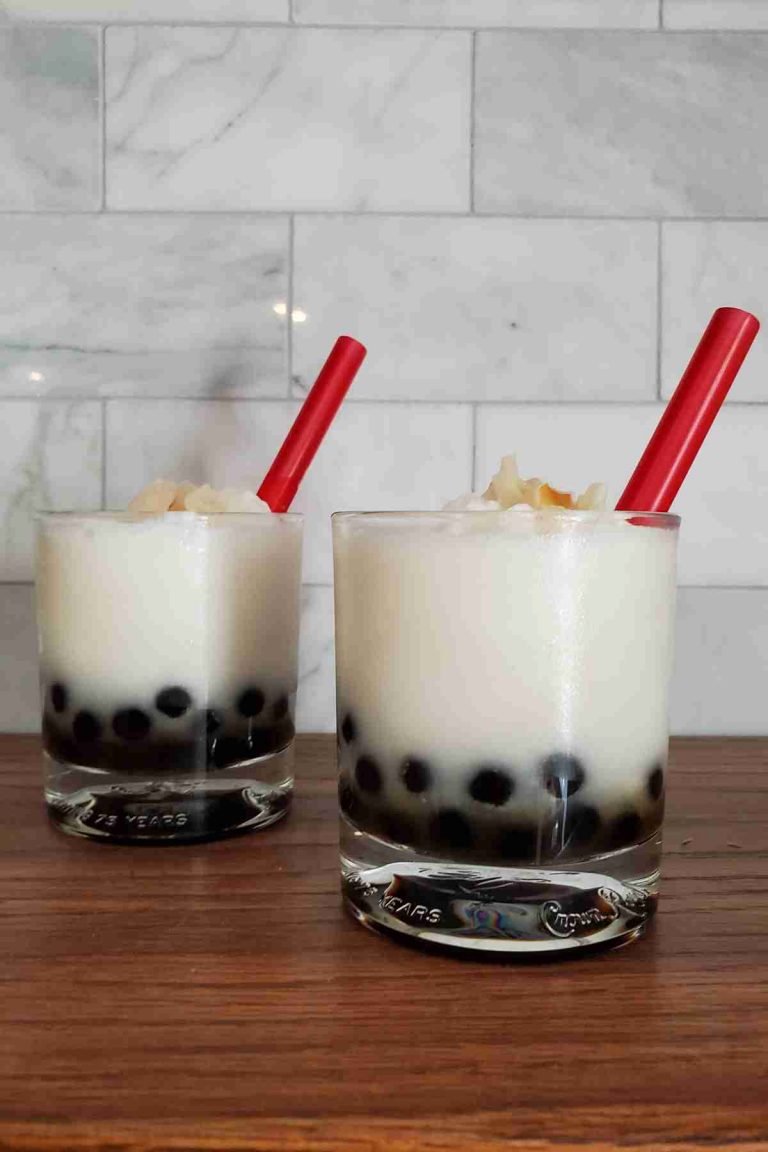This is the third type of spherification technique used to make popping boba. The other two are direct spherification and reverse spherification.
Contents
Cold Oil Spherification
Cold Oil Spherification is a useful method if you don’t have sodium alginate + calcium salt on hand or you don’t want to meticulously measure out everything to make sure you have the right concentration.
This method uses agar agar powder which is easily found in most grocery stores. Since cold oil spherification uses different process and ingredients, the texture of popping bobas made with this method will be different from popping bobas made from the traditional direct spherification method, although most people may not notice the difference.
Special equipment
- Measuring scale.
- Dropper, syringe, baster, caviar maker, or 1/4 teaspoon measuring spoon
- Slotted spoon
- Whisk
- Heat resistant bowl
- Blender or immersion blender (optional, but ideal)
What you need
- Calcium Salt (either calcium chloride, calcium lactate, or calcium lactate gluconate): the other main ingredient that interacts with sodium alginate to create popping boba
- Your choice of liquid or juice to encapsulate. Fruit juices or fruit flavorings are most commonly used, like passion fruit, strawberry juice or mango juice. You can sweeten it further with sugar or add food coloring to increase the color’s vibrancy.
- You may have issues if the pH is lower than 3.6, so try to start with juices that are not very acidic or add sodium citrate to raise the pH to at least 3.6.
- For liquids high in calcium (like dairy or orange juice) or that contain alcohol, you will need to use the reverse spherification method.
- Agar agar Powder
- Vegetable Oil
Cold Oil Spherification: alternative method if you don’t have sodium alginate
- Pour 1 cup of vegetable oil into a container and put it in the freezer for about 1 hour
- In a saucepan, combine 1 cup of the juice or flavored liquid of your choice and 1/2 teaspoon of agar agar powder
- Bring to a boil over medium heat while continuously stirring
- Allow to cool for 10 minutes, then transfer to a heat resistant bowl and allow to cool for an additional 10 minutes
- Fill a syringe or dropper with the juice + agar mixture
- Fill a bowl with cold water and set aside for rinsing the popping bobas. You may also add ice cubes to keep the water cold.
- Remove the oil from the freezer
- Squeeze the juice + agar mixture drop by drop into the chilled oil and the spheres will sink to the bottom
- Remove them with a slotted spoon and rinse them in the ice cold water bowl.
- Remove from the water and your popping bobas are ready for some popping! Add them to your favorite boba milk tea, ice cream, or shaved ice.
Tips
- Make sure your measurements are accurate. Having an accurate measuring scale is essential to ensure the reaction happens properly. This is the measuring scale I recommend.
- Use a blender or immersion blender to mix in sodium alginate.
- Sodium alginate can be challenging to mix in thoroughly, so having a blender or immersion blender will help a lot.
- When using a blender, make sure there is enough liquid to cover the blades. If there isn’t, the sodium alginate tends to collect on the top of the blade instead of dissolving into the liquid.
- I have found that a dropper or syringe created spheres that were too small and I prefer using a turkey baster or measuring spoon.
Storage
Popping boba is best enjoyed immediately at room temperature and you may refrigerate them if you prefer, but it’s not required.
If you need to store your popping boba for a short period of time, store them in a small container filled with the original juice or flavored liquid that does not contain sodium alginate. Do not store them in distilled water as they will become diluted through osmosis.
FAQs
Does popping boba contain gelatin?
No, these popping bobas do not contain gelatin.
Does popping boba contain gluten?
No, these popping bobas are gluten free.
Is popping boba healthy?
It’s healthier than regular boba because there’s less carbs and sugar if you choose a healthy liquid. Otherwise there is little nutritional value to popping boba.

How to Make Popping Boba Without Sodium Alginate (Cold Oil Spherification)
Equipment
- Dropper, syringe, baster, caviar maker, or 1/4 teaspoon measuring spoon
- Slotted spoon
- Heat resistant bowl
- Blender or immersion blender (optional, but ideal)
Ingredients
- 300 milliliter choice of liquid or juice to encapsulate
Instructions
- Pour 1 cup of vegetable oil into a container and put it in the freezer for about 1 hour
- In a saucepan, combine 1 cup of the juice or flavored liquid of your choice and 1/2 teaspoon of agar agar powder
- Bring to a boil over medium heat while continuously stirring
- Allow to cool for 10 minutes, then transfer to a heat resistant bowl and allow to cool for an additional 10 minutes
- Fill a syringe or dropper with the juice + agar mixture
- Fill a bowl with cold water and set aside for rinsing the popping bobas. You may also add ice cubes to keep the water cold.
- Remove the oil from the freezer
- Squeeze the juice + agar mixture drop by drop into the chilled oil and the spheres will sink to the bottom
- Remove them with a slotted spoon and rinse them in the ice cold water bowl.
- Remove from the water and your popping bobas are ready for some popping! Add them to your favorite boba milk tea, ice cream, or shaved ice.




